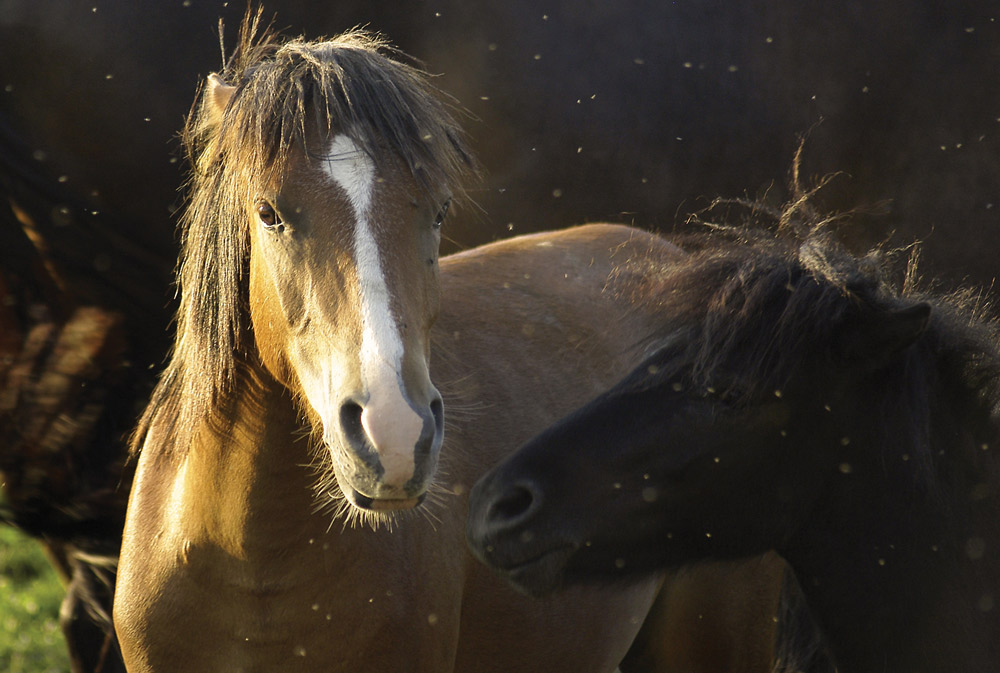Most veterinarians recommend horses get a West Nile vaccine every year. But how much do you actually know about the disease, the risk level and the vaccine?
A dozen years ago, you may never have even heard of West Nile virus, at least in connection with horses. Until 1999, in fact, it was virtually unknown in the US. But that year, 25 equine cases were reported on New York’s Long Island, and 13 of those horses died.
The disease was in Europe and parts of Africa for many years prior to that, but the horses in those countries developed natural immunity to pass along to their offspring. There was no natural immunity in the United States, so the death rate was initially very high.
The horse community panicked. Vaccines were rushed to the market, though nobody had bothered to create one before for the smaller countries. Vaccine use was even advertised on the radio – a very rare event for anything in the equine industry.
Disease Patterns
When a new disease arises, the initial infection rate is high because the animals (or humans) have no resistance. In other words, the immune system has no idea what the new bug is, so it cannot protect the body. Infected or exposed animals with strong immune systems may or may not show mild signs of the disease. When the immune system has been exercised by exposure, it produces antibodies (special immune cells) that are ready and waiting to protect against any exposure. Animals that get sick and recover usually also have these antibodies.
Once the immune system has been activated, the animal is able pass the immunity along to its offspring. New offspring and older horses with antibodies begin to form a group of naturally resistant horses. The numbers of active cases go down. With West Nile, both human and equine cases followed this pattern.
In 2000, equine West Nile virus cases increased to 65 in the northeast, and by 2002 there were over 14,000 cases across most states. But in 2003, that number dropped to just over 4,400, and in 2009 there were just 241 cases across the country, with many states reporting only a few. There are about 9.2 million horses in the country, so you can see that the infection rate and risk of disease are extremely low. There are a few hotbeds of activity, but these are widely scattered.
Although vaccination takes the credit for the reduction in cases, no humans have been vaccinated and the same diminishing pattern has occurred. And many horses across the country are not vaccinated regularly, especially those in poorer regions.
Know Thy Enemy
West Nile virus is primarily caused by a northern house mosquito that has bitten an infected bird and then gone on to bite a horse or human. Your horse cannot catch WNV from another horse – it must go through a bird, with crows and blue jays being the most common species affected. If you find these birds dead on your property, contact local authorities for a test.
Recognizing Symptoms
Symptoms can be variable, but usually involve some loss of coordination, impaired vision, muscle twitching, fever, inability to swallow, circling, hyper-excitability and other bizarre behaviors. These signs can mimic other neurologic diseases including rabies, botulism, EPM (equine protozoal myelitis), herpes, and Eastern, Western or Venezuelan encephalitis.
Be sure to call your vet immediately if your horse is behaving oddly, since any of these diseases can be life threatening and rabies can easily be transmitted to humans. A blood test is needed to confirm the diagnosis. Traditional treatment Conventional treatments for WNV can only support the horse while he works though the disease with his immune system. No effective antiviral drugs are available. Fluids, anti-inflammatories and protection from injury while the horse is uncoordinated are the main treatments.
Natural Aids
Natural treatments, especially homeopathic remedies, can be extremely useful. Supplements and herbs that assist the immune system are also very helpful, particularly vitamin C, Echinacea, the herb Isatis and Astragalus.
Homeopathic medicines should be used under the guidance of an experienced veterinary homeopath since WNV can be serious and the remedies needed can change rapidly. Remedies to consider include Belladonna (this may be one of the most important), Aconite, Nat Mur, China, Nux Vomica, Phos and Sulphur. Mild to moderate cases treated with homeopathy and supportive care have recovered well. Severe cases are difficult to treat with any medicine, especially if the horse is down and cannot get up.
An Ounce of Prevention
Standing water is a breeding ground for mosquito larvae. One of the most important ways of preventing West Nile virus is to remove any sources of standing water from around the farm. This includes cleaning gutters and removing old buckets, cans and discarded tires. Mosquito dunks that contain a harmless bacteria (Bt-israelensis) can be used in water tanks. If you have large tanks, you can use goldfish. Stagnant water will breed mosquitoes after just four days.
Should I Vaccinate?
Vaccination is considered the key way to prevent WNV, but go back to the beginning of this article and think about whether it’s really needed. Also check the USDA website (above) for the number of cases in your state. Many states have zero to three cases among hundreds of thousands of horses, so the incidence is extremely low.
The American Association of Equine Practitioners considers the WNV vaccine to be one every horse should have. However, my practice has been testing WNV antibody titers (the measure of the immune response to vaccines or disease). The majority of horses have a very strong titer, including those who were not vaccinated or sick. This indicates there may have been some natural exposure.
The vaccines have many reported side effects, though it has been hard to prove this to the satisfaction of the drug companies. To vaccinate or not is a personal decision. Consider the risk of your horse contracting West Nile virus (low), the risks of the disease itself (moderate to serious), and the risks associated with the vaccine (reports of side effects are plentiful). Then make your own decision based on your situation and the prevalence of equine WNV in your area. Ask your veterinarian how many cases he has seen in the last one to two years.
From a holistic perspective, vaccinations are documented to stress the immune system, especially when multiple vaccines are given bi-annually. Many horses’ immune systems become compromised, with allergies, illness and poor performance as the main signs. When treated with homeopathy and Chinese medicine, the horse’s health improves dramatically. The more immune compromised an animal is, the more likely he is to come down with every disease, including WNV.
The best way to improve your horse’s immune system is to feed whole foods and whole food supplements whenever possible, along with general immune supplements such as flax or chia seeds and herbs. If your horse shows signs of any chronic problem, including a poor quality coat, poor feet or a bit of a cough, find a holistic-minded veterinarian to help you strengthen his immune system and enhance his overall health and resistance to WNV and other diseases.
Joyce Harman, DVM, MRCVS, graduated in 1984 from Virginia Maryland Regional College of Veterinary Medicine. She is certified in veterinary acupuncture and chiropractic and has completed advanced training in homeopathy and herbal medicine. Her practice in Virginia uses 100% holistic medicine to treat all types of horses. Her publications include The Horse’s Pain-Free Back and Saddle- Fit Book– the most complete source of information about English saddles – and The Western Horse’s Pain-Free Back and Saddle-Fit Book. harmanyequine.com








